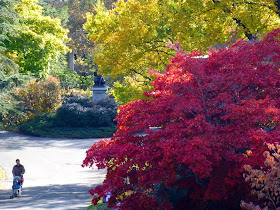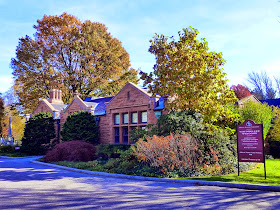In my last visit I was collecting entrepreneurs, and I was interested this time in adding to that list. But it's worth saying that Mount Auburn itself is also one of the most interesting social innovations of the 19th century: go visit King's Chapel graveyard in Boston and then head out to Mount Auburn. It's hard to be more innovative than changing the way people think about death and remember their loved ones.
Below is King's Chapel on a summer day in 2009.
I won't press the point, but there might be a half dozen people per family grave (dust to dust was taken literally), all confined to a rapidly growing urban environment dependent on clean aquifers and wells.
By way of contrast, see Mount Auburn below. It was made for strolling, for unfurling an oriental rug and laying out a picnic in your large family plot on a Saturday afternoon. The day we were there last weekend the 170 acres were filled with visitors.

A group of us took a tour called "Not So Rich or Famous," an introduction to a number of folks who had interesting, full, sometimes very difficult lives--but who have been mostly lost to history. Thanks to some hardworking folks at Mount Auburn, however, their stories are starting to be told.
Along the way we walked by the gravesite of Dorothea Dix (1802-1887). In life, she was an absolute force whose tireless work on behalf of the mentally ill led to national and international reforms. She also served as Superintendent of Nurses for the United States during the Civil War. Her stone is as plain and unadorned as the dress (and intentions) she expected of her young nurses treating wounded Union soldiers.
We also visited with Charles Fox Hovey (1807-1859), buried in the Hovey family plot in the "bed" on the right. Hovey founded a dry goods/innovative department store in Boston that would be acquired by Jordan Marsh in 1947. He supported abolition and helped fund the first National Women's Rights Convention in 1850.
Some interesting details on Hovey's retail history are here.
This was on one of our excellent tour guides flashing a picture of a spreading chestnut tree," as in Longfellow's "Under the spreading chestnut tree, the village smithy stands. . . ."
Today, the gravestone of the village smithy--Dexter Pratt--still stands, though the environment has made it mostly unreadable. (Note to entrepreneurs looking for a Big Idea: Why hasn't anyone come up with a gravestone sealant that protects from acid rain and repels fungus? Our cemeteries and graveyards are crumbling around us.)
The Dexter Pratt House is on Brattle Street in Cambridge should you care to visit. The chestnut tree is long gone, having been turned into a chair for Longfellow in 1879.
The second name on the gravestone below is one of an early civil rights hero. Benjamin Roberts, a black resident of Boston, attempted to enroll his five-year-old daughter in a (much closer and better funded) whites-only school in that city. The result, Roberts v. Boston (1850), sought to end racial discrimination but lost on Constitutional grounds--since we know, of course, that the Founding Fathers wrote the Constitution specifically to accommodate slavery and discrimination. The Supreme Court used Roberts v. Boston to support Plessy v. Ferguson in 1896, leading to a half-century of court-endorsed separate-but-equal Jim Crow. Thanks to the folks at Mount Auburn for preserving this stone and important story.
Here's our other excellent tour guide standing in front of the enormous wall that separates Mount Auburn's Boston Brahmin from a immense Catholic cemetery on the other side. I did not see guards or turrets, nor do I know if any Catholics have ever made it over the wall. It is possible that one or more Protestants have snuck out of the cemetery since 1831, however.
This is the stone of Kittie Know, whose story has only recently come to light (and whose stone is only about a year old). Kittie was a seamstress, born of a black father and white mother, who became a prominent cyclists during America's first biking craze. The Boston Globe story is here. Again, kudos to Mount Auburn for helping keep all the history alive.
And finally, this is the six-family-lot enclosure of the Lawrence family, whose Abbott Lawrence (1792-1855) represented some of the real money in America at the time Mount Auburn was founded. Cotton, textile mills, the railroad, Congress, VP candidate--Abbott led a long, fruitful life in the boom-boom years before the Civil War. In death he managed to keep his family close.
As Maslow said: to a person whose only tool is a hammer, everything looks like a nail. Well, to a person with a camera, everything looks like a picture. The rest of the post is me indulging. Enjoy Mount Auburn on a perfect autumn day.
I do like the idea of lining up the family like chess pieces for any battle faced in the afterlife.
This is a Japanese maple. It would be nice to have one in the backyard. . .
Did I mention I like these Japanese maples?
Here's that wall again. No escapes reported the day we were there.



































